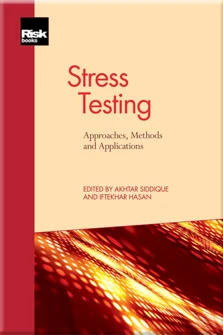A Framework for Stress Testing Banks’ Corporate Credit Portfolio
Olivier de Bandt, Nicolas Dumontaux, Vincent Martin and Denys Médée
Introduction to Stress Testing: Approaches, Methods and Applications
Governance over Stress Testing
Stress Testing and Other Risk-Management Tools
Stress Testing for Market Risk
The Evolution of Stress Testing Counterparty Exposures
Operational Risk: An Overview of Stress-Testing Methodologies
Stress Testing of Bank Loan Portfolios as a Diagnostic Tool
Stress-Test Modelling for Loan Losses and Reserves
A Framework for Stress Testing Banks’ Corporate Credit Portfolio
EU-Wide Stress Test: The Experience of the EBA
Stress Testing Across International Exposures and Activities
Liquidity Risk: The Case of the Brazilian Banking System
Determining the Severity of Macroeconomic Stress Scenarios
Since the financial crisis of 2007 and beyond, which drew unprecedented attention to the stress testing of financial institutions, stress-tests exercises have become a central risk-management tool to assess the potential impact of extreme events on banks’ P&L and balance-sheet structures.
Stress tests are viewed as complementary to traditional risk-measurement metrics such as value-at-risk (VaR), as they are an important mechanism for detecting weaknesses of both a single financial institution and threats to financial stability. Nowadays, financial institutions are required to perform regular exercises within Pillar II of the regulatory framework of the Basel Accord in order to assess the global impact of adverse events or changes in market conditions on banks’ capital adequacy. Supervisory authorities as well are used to leading such exercises: the International Monetary Fund (IMF) with its regular Financial Sector Assessment Program, the European Banking Authority (EBA) with its European “bottom-up” stress tests, including a disclosure step, and national supervisory authorities, which all have built dedicated tools, especially for regular top-down exercises. The scope of stress
Copyright Infopro Digital Limited. All rights reserved.
As outlined in our terms and conditions, https://www.infopro-digital.com/terms-and-conditions/subscriptions/ (point 2.4), printing is limited to a single copy.
If you would like to purchase additional rights please email info@risk.net
Copyright Infopro Digital Limited. All rights reserved.
You may share this content using our article tools. As outlined in our terms and conditions, https://www.infopro-digital.com/terms-and-conditions/subscriptions/ (clause 2.4), an Authorised User may only make one copy of the materials for their own personal use. You must also comply with the restrictions in clause 2.5.
If you would like to purchase additional rights please email info@risk.net











